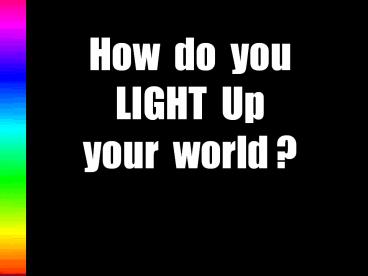What Wavelength Was That? - PowerPoint PPT Presentation
1 / 14
Title:
What Wavelength Was That?
Description:
Title: What Wavelength Was That? Author: Christine Royce Last modified by: harris.michelle Created Date: 3/19/2003 1:24:00 PM Document presentation format – PowerPoint PPT presentation
Number of Views:76
Avg rating:3.0/5.0
Title: What Wavelength Was That?
1
How do you LIGHT Up your world ?
2
Welcome to a power point presentation on LIGHT.
- We will investigate the following
- 1. What is light?
- 2.What are some sources of light around us?
- 3. What are opaque, transparent, translucent
- objects?
- 4. What is a light wave?
3
Light
- Our primary source of light is the sun.
- Light travels in straight lines at a speed of
186,000 miles per second. - Light waves travel faster than sound waves!
- Light energy from the sun travels through space ,
reaches earth, and some of it turns to heat
energy and warms the earths air. - Light from the sun also travels to the cells of
green plants (producers) and is stored as energy. - When light reaches an object, it is absorbed,
reflected, or passes through it.
4
Sensing Light
- Humans have two light detectors.
- Do you know what they are called?
5
How many sources of Light can you list and
explain?
- SUNwarms air,
- water, and land.
- Fireprovides heat, light, and cooking fuel.
- Lightning
- Firefly
- Flashlight
- Light bulb
- Laser beams
- Optical
- telephone
- fibers
- Traffic lights
6
Can you answer these questions?
- 1. A person will see a flash of lightning before
they hear the thunder that goes with it because?
- 2.Can you draw a long wavelength and a short
wavelength next to it? - 3.What scientific tools are used to study light?
- 4. Can you contrast objects that are transparent,
translucent, and opaque?
7
Just Passing Through What happens when light
strikes glass? Or waxed paper? Or a book?
- If light travels through an object it is
transparent - If light is blocked by an object and a dark
shadow is cast it is opaque. - If some light passes through but not all and a
light shadow is present it istranslucent.
8
What happens when light hits these objects?
- Glass of water
- School bus window
- Notebook paper
- Waxed paper
- Plastic wrap
- Tissue paper
- Cardboard
- Textbook
- Hand lens
9
Transparent objects
- The windows on a school bus,
- A clear empty glass,
- A clear window pane,
- The lenses of some eyeglasses,
- Clear plastic wrap,
- The glass on a clock,
- A hand lens,
- Colored glass
- ALL of these are transparent. Yes, we can see
through them because light passes through each of
them.
10
Translucent objects
- Thin tissue paper,
- Waxed paper,
- Tinted car windows,
- Frosted glass,
- Clouds,
- All of these materials are translucent and allow
some light to pass but the light cannot be
clearly seen through.
11
Opaque objects
- Heavy weight paper,
- Cardboard
- Aluminum foil,
- Mirror, bricks, buildings,
- Your eyelids and hands,
- Solid wood door,
- All of these objects are opaque because light
cannot pass through them at all. - They cast a dark shadow.
12
Lets find out how light travels?
- Simple Activity 1 working flashlight
- 1. Shine a flashlight on a wall.
- 2. Does light from the flashlight reach the wall?
How do you know? - 3. What evidence do you have showing light
travels in a straight line? - 4.Record answers in your science journal
- 5.Move closer with the flashlight.
- Any changes? Write a story about light.
13
What is light really?
- Light waves are three dimensional.
- Light waves vibrate in all planes around a center
line. - The waves have high points called peaks.
- Waves also have low points called valleys.
- The distance from one crest to the next crest is
called a wavelength. - The number of waves passing a given point in one
second is called the frequency.
wavelength
14
Notice the wavelength is long(Radio waves) and
gets shorter (Gamma Rays)































